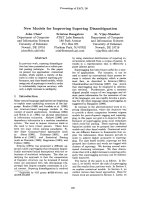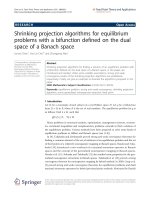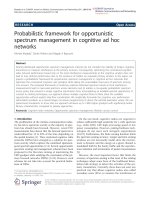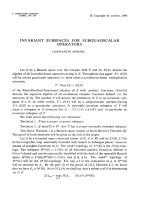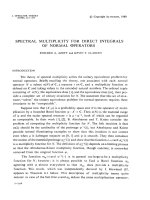Báo cáo toán học: "New Bounds for Codes Identifying Vertices in Graphs" pdf
Bạn đang xem bản rút gọn của tài liệu. Xem và tải ngay bản đầy đủ của tài liệu tại đây (187.3 KB, 14 trang )
New Bounds for Codes Identifying
Vertices in Graphs
G´erard Cohen
Iiro Honkala
Antoine Lobstein
Gilles Z´emor
Abstract
Let G =(V,E) be an undirected graph. Let C be a subset of vertices that
we shall call a code. For any vertex v ∈ V , the neighbouring set N(v,C)is
the set of vertices of C at distance at most one from v. We say that the code
C identifies the vertices of G if the neighbouring sets N(v, C),v ∈ V, are all
nonempty and different. What is the smallest size of an identifying code C ?
We focus on the case when G is the two-dimensional square lattice and improve
previous upper and lower bounds on the minimum size of such a code.
AMS subject classification: 05C70, 68R10, 94B99, 94C12.
Submitted: February 12, 1999; Accepted: March 15, 1999.
G. Cohen, A. Lobstein and G. Z´emor are with ENST and CNRS URA 820, Computer
Science and Network Dept., Paris, France, I. Honkala is with Turku University, Mathematics
Dept., Turku, Finland
the electronic journal of combinatorics 6 (1999), #R19 2
1 Introduction
In this paper, we investigate a problem initiated in [3]: given an undirected graph
G =(V,E), we define B(v), the ball of radius one centered at a vertex v ∈ V ,by
B(v)={x ∈ V : d(x, v) ≤ 1},
where d(x, v) represents the number of edges in a shortest path between v and x.
The vertex v is then said to cover all the elements of B(v). We often refer to a
distinguished subset C of V as a code, and to its elements as codewords.
AcodeC is called a covering if the sets B(v) ∩ C, v ∈ V , are all nonempty; if
furthermore they are all different, C is called an identifying code. The set of codewords
covering a vertex v is called the identifying set (I-set) of v.
Now, what is the minimum cardinality of an identifying code ? This problem
originates in [3] and is also taken up in [1].
Let us mention an application. A processor network can be modeled by an undi-
rected graph G =(V,E), where V is the set of processors and E the set of their links.
AselectedsubsetC of the processors constitutes the code. Its codewords report to
a central controler the state of their neighbourhoods (typically, balls of radius one)
by sending one bit of information (e.g., 1 if it does not contain a faulty processor, 0
otherwise). Based on these |C| bits, the controler must locate the faulty processor.
Common network architectures are the n-cube or the two-dimensional mesh or grid.
In this paper we focus on the case when G is a square grid drawn on a torus, that
is G is the graph
nm
with vertex set V = /n ×/m and edge set E = {{u, v} :
u −v =(±1, 0) or u − v =(0, ±1)}. We shall also consider the limiting infinite case,
i.e. when G is the graph with vertex set × .Thedensity D(C)ofC ⊆ V is
defined as |C|/|V | for
nm
and for the infinite graph as
D(C) = lim sup
n→∞
|C ∩Q
n
|
|Q
n
|
where Q
n
is the set of vertices (x, y) ∈ V such that |x|≤n and |y|≤n.
An example of an identifying code of isgiveninfigure1. Itistakenfrom[3]
and its density is 3/8. Our purpose is to determine the minimum density D of an
identifying code of . It is proved in [3] that 1/3 ≤ D ≤ 3/8. We shall improve
this to
23
66
≤ D ≤
5
14
.
the electronic journal of combinatorics 6 (1999), #R19 3
①
①
①
①
①
①
①
①
①
①
①
①
①
①
①
①
①
①
①
①
①
①
①
①
①
①
①
①
①
①
①
①
①
①
①
①
①
①
①
①
①
①
①
①
①
①
①
①
①
①
①
①
①
①
①
①
①
①
①
①
①
①
①
①
①
①
①
①
①
①
①
①
Figure 1: The pattern is periodic and extends to
2
with density 3/8.
2 Lower bounds
For a given finite regular graph G =(V,E), let B = |B(v)| denote the size (indepen-
dent of its centre) of a ball of radius one; let C be an identifying code. Since C is a
covering of V ,thesphere-covering bound holds:
|C|·B ≥|V |.
But the identifying property implies a strictly better bound : let L
1
denote the set
of vertices identified by singletons; now |V |−|L
1
| verticeshaveI-setsofsizeatleast
two. In other words, C is a double covering (see [2, Ch. 14]) of these vertices; thus,
using the fact that |L
1
|≤|C|,wehave:
|C|·B ≥ 2(|V |−|L
1
|)+|L
1
| =2|V |−|L
1
|≥2|V |−|C|.
We obtain, [3]
|C|·
B +1
2
≥|V |. (2.1)
Bound (2.1) can be tight in some graphs, for example the triangular lattice, see [3].
2.1 The graphs
nm
Until the end of this section G will be a finite torus
nm
with n, m ≥ 30, say. All balls
of radius one have cardinality five. For i =1, 2, 3, 4, 5, let L
i
be the set of vertices
identified by a set of exactly i codewords. Set
i
= |L
i
|, L
≥3
= L
3
∪ L
4
∪ L
5
and
the electronic journal of combinatorics 6 (1999), #R19 4
Figure 2: An element of C
.
≥3
= |L
≥3
|. Counting in two ways the number of couples (c, x)suchthatc ∈ C,
x ∈ V and d(c, x) ≤ 1, we get:
5|C| =
1≤i≤5
i
i
. (2.2)
From (2.2), we infer that 5|C| =
1
+2(|V |−
1
−
≥3
)+3
≥3
+
4
+2
5
.Since
1
≤|C|, we obtain:
6|C|≥2|V | +
≥3
+
4
+2
5
. (2.3)
If it were possible that
≥3
= 0 then the bound (2.3) would collapse to (2.1). But this
is not the case for the square grids and for the rest of this section we shall bound
≥3
from below as tightly as we can.
2.2 Partitioning C
We partition the code C into two subcodes C
and C
,withC
consisting of all
codewords belonging to at least one I-set of cardinality at least three. Thus, C
is the
set of all codewords belonging only to I-sets of size one or two. Our strategy will be
to bound
≥3
from below by a function of |C
|. First, some facts about C
and C
.
In G, any vertex c
∈ C
has the neighbouring configuration of figure 2, where the
black square represents c
,awhitesquarerepresentsanelementofC,andacross
represents a vertex not in C.
the electronic journal of combinatorics 6 (1999), #R19 5
d
e
f
g
1
d
e
f
g
1
2
d
e
f
g
1
2
d
e
f
g
1
2
3
d
e
f
g
1
2
3
4
Figure 3: Forbidden configurations of two elements of C
.
Indeed, suppose that a codeword c ∈ C is on e3; then, in order to give c
and c
distinct I-sets, c
should belong to an I-set of size at least three. If c ∈ C is on e2,
then, in order to give e3andf2 distinct I-sets, again c
must belong to an I-set of
size at least three. This contradicts the definition of C
. Finally, d3, f1, f5andh3
belong to C because e3, f2, f4andg3 must have an I-set which is not reduced to
{c
}. Actually, using similar arguments, it is easy to check (see figure 3) that two
elements of C
cannot be at Euclidean distance 3 (e.g., on d1andg1),
√
5(ond1and
f2),
√
10 (on d1andg2), 2
√
2(ond1andf3), and even 3
√
2(ond1andg4) from
one another.
Obviously, we have 3
3
+4
4
+5
5
≥|C
|, i.e.,
3
≥3
+
4
+2
5
≥|C
|. (2.4)
Let
4
= α
≥3
,
5
= β
≥3
(with α, β, α + β ∈ [0, 1]). Then
≥3
≥
|C
|
3+α +2β
.
Combining with (2.3), this leads to
6|C|≥2|V | + |C
|(1 −
2
3+α +2β
).
The right hand side is smallest when α = β =0,hence
the electronic journal of combinatorics 6 (1999), #R19 6
Figure 4: An element of C
with degree two in Γ.
Lemma 2.1 6|C|≥2|V | + |C
|/3.
2.3 An incidence relation between C
and L
≥
3
For any vertex v,letR(v) be the set of points at Euclidean distance either 2 or
√
5
from v. Now let us consider the bipartite graph Γ whose set of vertices is C
∪ L
≥3
,
and whose set of edges is included in C
× L
≥3
,withanedgebetweenc
∈ C
and
x ∈ L
≥3
if and only if x ∈ C ∩R(c
). We now study possible degrees in Γ.
Lemma 2.2 Any element of C
has degree at least two in Γ.
Proof. Consider again figure 2. To identify e4, we can assume, without loss of
generality, that there is a codeword in e5. Since e5andf5musthavedistinctI-sets,
at least one of them must have at least a third element in its I-set. The same is true
for f1andg1, or h2andh3, according to which place you choose for covering g2.
Actually, the only way for c
∈ C
to have degree exactly two is given by figure 4 (or
its rotation).
Lemma 2.3 Any element of L
≥3
has degree at most three in Γ.
Proof. Assume that a codeword x in L
≥3
has degree four: four distinct codewords
c
1
, c
2
, c
3
,andc
4
of C
are adjacent to x in Γ. For each i, c
i
∈ R(x), because x ∈ R(c
i
),
and figure 5 shows, with black squares, the twelve possible locations for the four c
i
’s
around x; figure 5 also gives the two possible ways of identifying the vertex x on f3
the electronic journal of combinatorics 6 (1999), #R19 7
Figure 5: R(x), the set of possible locations for elements of C
.
with three codewords, represented as white squares (more elements in the I-set of x
would only mean more restrictions on the c
i
’s). Now, keeping in mind figure 2 and
the forbidden configurations of figure 3 it is not difficult to check that choosing four
c
i
’s among these twelve positions is impossible, and furthermore that figure 6 gives
the only possible configurations with three elements of C
in R(x) (this will help in
proving our following lemma).
Lemma 2.4 If an element of L
≥3
has degree three in Γ, then at least two of its
neighbours in Γ have degree at least four.
Proof. Let us consider Configuration (b) of figure 6. There is necessarily a codeword
on f7, in order to identify f6. The points f2andf4 have different I-sets, so there
is a codeword on e2. SoinΓwehavetheedges(e5,f7), (e5,f3), (e5,e3); (g5,f7),
(g5,f3); (g1,f3), (g1,e2). Now in order to cover d6andd4, we must increase the
degree of e5, and this will do nothing for the covering of h6, h4, h2, f0andh0. For
h4andh6 we have two possibilities. Either we do not take h3asacodeword: this
allows the degree of g5toincreasebyoneonly(ifwetakei4andi6ascodewords).
But then the covering of h2, f0andh0 requires an increase of the degree of g1ofat
least two, and in the best case we end up with degrees four, three and four for e5,g5
and g1, respectively. Or we take h3inC:nowg3isinL
≥3
∩C and the degrees of g5
and g1 both increase. The covering of h6, f0andh0 will necessarily lead to another
increase, and we end up with degrees at least four in Γ.
the electronic journal of combinatorics 6 (1999), #R19 8
Figure 6: Possible locations for three elements of C
in R(x).
the electronic journal of combinatorics 6 (1999), #R19 9
In Configuration (a) of figure 6, there must also be a codeword on f7, so the two
elements of C
, e5andg5, have f7andf3asneighboursinΓ.Wenowprovethatg5
has at least two more edges in Γ; by symmetry, the same will be true for e5, proving
our lemma.
Because h6mustbecovered,h7ori6areinC.Ifh7 ∈ C, then the fact that h4
hastobecoveredgivestheclaim. Assumethati6 ∈ C.Sinceh4mustbecovered,
h3ori4belongtoC.Ifh3 ∈ C, we are done. If i4 ∈ C and h3 /∈ C,theni3 ∈ C,
because h3andg2musthavedistinctI-sets.
In all cases, g5 has degree at least four in Γ.
Corollary 2.5
≥3
≥|C
|.
Proof. We partition L
≥3
into two sets, A and B: A is the set of vertices with degree
exactly three in Γ and B is the set of vertices with degree at most two in Γ. We
partition C
into two sets, X and Y : X contains the vertices having degree two or
three in Γ and Y contains the vertices having degree at least four in Γ. Let a, b,
c and d be the number of edges between X and A, X and B, Y and A, Y and B,
respectively. Counting in different ways the edges of Γ, we obtain:
c + d ≥ 4|Y |,a+ b ≥ 2|X|,a+ c =3|A|,b+ d ≤ 2|B|,
or
4|Y |−d ≤ c =3|A|−a (2.5)
and
2|X|−a ≤ b ≤ 2|B|−d. (2.6)
This leads to 4|C
|≤3|A| +4|B|+ a −d. But Lemma 2.4 implies
a ≤|A|. (2.7)
Therefore, 4|C
|≤4
≥3
− d ≤ 4
≥3
.
We will now improve on this last result by showing that X and B cannot be both
made up only of vertices of degree two in Γ.
2.4 A refined analysis of the degrees in
Γ
Let us further partition the sets X and B:letC
2
and C
3
be the subsets of X with
vertices of degree two and three in Γ, respectively; let B
0
, B
1
,andB
2
be the subsets
of B containing vertices of degree zero, one, and two in Γ, respectively.
We study the elements of C
2
and start from figure 4. Because d2,d3andd4must
have distinct I-sets, we see that at least one of c2andc4mustbelongtoC:wecan
assume, by symmetry, that c4 ∈ C.Thenc3orc2areinC,andc3 ∈ L
≥3
.
the electronic journal of combinatorics 6 (1999), #R19 10
Case A: c3 /∈ C. It implies that c2 ∈ C and c3 has degree zero in Γ.
Case B: c3 ∈ C.Whatdegreecanc3 have in Γ? There are only four possible places for
elements of C
around c3: a2, a3, a4andc1. Keeping in mind the forbidden distances
between two elements of C
, it is easy to check that there are three possibilities: 1)
c3 has degree zero in Γ; 2) c3 has degree one in Γ, and any of these four places is
possible; 3) c3hasdegreetwoinΓandnecessarilya4 ∈ C
(the other neighbour of
c3inΓbeinga2orc1).
Case B1: c3 has degree zero in Γ.
Case B2: c3 has degree one in Γ.
Case B3: c3hasdegreetwoinΓ.Thisimpliesthata4 ∈ C
(and c1ora2isinC
).
Case B3a: c5 ∈ C. This implies that c4 ∈ L
≥3
∩C;moreover,c4 has degree one in Γ,
a4 being its only neighbour.
Case B3b: c5 /∈ C. Thisimpliesthatb6 ∈ C (to cover b5) and d6 ∈ C (because e4
and d5 have distinct I-sets). The vertex e6 is not a codeword, and, since its I-set is
different from that of d5, e6 ∈ L
≥3
, with degree zero in Γ.
In these five cases, we have exhibited a vertex with degree zero or one in Γ. Of
course, each time, a second one exists in a symmetric position, on column g or i.
Now we gather Cases A and B3b, which generated elements of L
≥3
\C (of degree
zero in Γ); and Cases B2 and B3a, which generated codewords of degree one in Γ.
Case B1 has produced a codeword with degree zero in Γ. The point is to see how
many elements of C
2
could produce the same vertex. Thenwecanhaveanestimate
on the number of elements which have degree zero or one in Γ, thus improving the
inequality linking |C
| and
≥3
.
We give a sketch only for Cases A and B3b. The other cases are very similar. The
following remark will be useful: two elements of C
2
cannot be at distance two from
each other.
In Case A (resp., B3b), we produced an element of L
≥3
\ C, c3 (resp., e6), at
Euclidean distance 3 (resp.,
√
10) from our starting point f3 ∈ C
2
.InCaseA,apart
from f3, the only possible location for an element of C
2
at Euclidean distance 3 from
c3isz3. In Case B3b, apart from f3, the only possible locations for an element of C
2
at Euclidean distance
√
10 from e6ared9andf9, but, using our preliminary remark,
at most one is possible. One “crossing” between Case A and Case B3b can occur only
when there is an element of C
2
on e9, which excludes d9andf9. So in this case, one
vertex with degree zero in Γ is shared by at most two elements of C
2
.
In Cases B2 and B3a, one vertex with degree one is shared by at most two elements
of C
2
. In case B1, at most two elements of C
2
generate the same vertex of degree
zero.
Since, by symmetry, one element in C
2
produces two vertices with degree zero or
the electronic journal of combinatorics 6 (1999), #R19 11
oneinΓ,wehaveshown:
Lemma 2.6 |B
0
|+ |B
1
|≥|C
2
|.
Now, following (2.6), we have 2|C
2
|+3|C
3
|−a = b ≤ 2|B
2
|+|B
1
|−d,or3|X|−|C
2
|≤
2|B
2
| + |B
1
| + a − d. By the previous lemma, this implies that
3|X|≤2|B
2
| +2|B
1
| + |B
0
| + a − d =2|B|−|B
0
| + a − d.
Thus
3|X|≤2|B| + a −d, (2.8)
which improves on (2.6) and, together with (2.5) and (2.7), leads to
4|C
|≤3|A|+
8
3
|B|+
1
3
a −
1
3
d ≤
10
3
|A| +
8
3
|B|−
1
3
d ≤
10
3
≥3
,
and we have just proved:
Lemma 2.7
≥3
≥ 6|C
|/5.
Corollary 2.8 6|C|≥2|V | +6|C
|/5.
Proof. By (2.3), 6|C|≥2|V | +
≥3
≥ 2|V | +6|C
|/5.
Since |C
| + |C
| = |C|, Lemma 2.1 and the above corollary yield:
66|C|≥23|V |. (2.9)
By letting the two dimensions of
mn
grow to infinity, we obtain
Theorem 2.9 The minimum density of an identifying code of the infinite square
lattice satisfies D ≥ 23/66.
Remark : more detailed study of the possible degrees in Γ can lead to small improve-
ments in the lower bound. For example, further refining the above argument can lead
to the condition d ≥ a which gives
≥3
≥ 4|C
|/3andD ≥ 15/43 ≈ 23/66 + 0.00035
(see [4]). But analysis of the above type tends to become more and more intricate
and the improvements to the lower bound less and less significant.
the electronic journal of combinatorics 6 (1999), #R19 12
3 A new construction
Consider the pattern of figure 7. This is an alternative construction to figure 1. One
readily checks that it makes up an identifying code of density 3/8. Notice that it
can be modified to yield the construction of figure 8 with the same density. But
this identifying code is not optimal. Codewords can be deleted without losing the
identifying property. We obtain the code of figure 9. Hence :
Theorem 3.1
The minimum density of an identifying code of the infinite square
lattice satisfies D ≤ 5/14.
References
[1] U. Blass, I. Honkala and S. Litsyn: Bounds on identifying codes, Discrete Math.,
to appear.
[2]G.D.Cohen,I.Honkala,S.LitsynandA.Lobstein:Covering Codes, Elsevier,
1997.
[3] M.G.Karpovsky,K.ChakrabartyandL.B.Levitin: Onanewclassofcodes
for identifying vertices in graphs, IEEE Trans. Inform. Th., vol. 44, pp. 599–611,
1998.
[4] />the electronic journal of combinatorics 6 (1999), #R19 13
①①①①①①
①①①①①①
①①①①①①
①①①①①①
①①①①①①
①①①①①①
①①①①①①
①①①①①①
①①①①①①
①①①①①①
①①①①①①
①①①①①①
Figure 7: An alternative periodic identifying code of density 3/8.
①①①①①①①①①①①①①①
①①①①①①①①①①①①①①
①①①①①①①①①①①①①①
①①①①①①①①①①①①①①
①①①①①①①①①①①①①①
①①①①①①①①①①①①①①
①①①①①①①①①①①①①①
①①①①①①①①①①①①①①
①①①①①①①
①① ①①①①① ①①①
①①①
①
①
①
①
①
①
①
①
①①①①① ①①①①①
①①①①① ①①①①①
①
①
①
①
①
①
①
①
Figure 8: Another periodic identifying code of density 3/8.
the electronic journal of combinatorics 6 (1999), #R19 14
①①①①①①①①①①①①①①
①①①①①①①①①①①①①①
①①①①①①①①①①①①①①
①①①①①①①①①①①①①①
①①①①①①①①①①①①①①
①①①①①①①①①①①①①①
①①①①①①①①①①①①①①
①①①①①①①①①①①①①①
①① ①①①①
①① ①① ①① ①①
①①
①
①
①
①
①
①
①
①
①① ①① ①① ①①
①① ①① ①① ①①
①
①
①
①
①
①
①
①
❤
❤
❤
❤
❤
❤
❤
❤
The eight white codewords in the picture can be deleted
without losing the identifying property. We obtain a
periodic tiling of
2
by the tile below.
①①①①①①①
①①①①①①①
①①①①①①①
①①①①①①①
①① ①①
①① ①①
①
①
①
①
Figure 9: The improved identifying code : the tile is of size 112 and contains 40
codewords. Hence the density 40/112 = 5/14.
